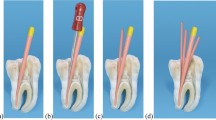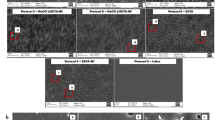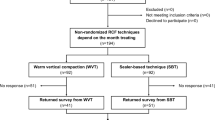Abstract
Purpose of Review
Filling the root canal is necessary when the dental pulp is lost as the dead space will be colonised by bacteria, leading to reinfection of the root canal and treatment failure. Treatment methodology depends on the extent of root formation and the choice of materials available. This review looks at the classical clinical methods and also queries if the newer materials change the treatment rationale.
Recent Findings
There is considerable confusion with nomenclature for some classes of dental materials. The newer materials have specific features that may not address the treatment needs. Nonetheless, the use of bioceramics and related materials definitely modifies and improves treatment outcome.
Summary
The classical treatment methods for filling the root canals of both immature and mature teeth are quite well-established in clinical practice. Open apices are treated with calcium hydroxide paste for an extended period of time to stimulate barrier formation at the apex, and the roots are then obturated in a similar way to adult teeth using a solid cone and root canal sealer. With the introduction of bioceramics and related materials, treatment of the immature apex has been shortened to one to two visits. Bioceramic root canal sealers have changed the concept of root canal obturation from the concept of hermetic seal and inert materials to biological bonding and activity. The introduction of these materials has certainly changed the clinical outcomes of filling the root canals. Treatment time has been reduced, which is beneficial for the treatment of paediatric patients. The chemical bond and antimicrobial properties of the sealers in conjunction with hydraulic properties are promising and can potentially improve the clinical success of treatment. Further research is necessary to be able to define clinical protocols for the use of these materials in order to optimise their properties.

Similar content being viewed by others
References
Papers of particular interest, published recently, have been highlighted as: • Of importance •• Of major importance
Torabinejad M, Chivian N. Clinical applications of mineral trioxide aggregate. J Endod. 1999;25(3):197–205.
Camilleri J, Montesin FE, Brady K, Sweeney R, Curtis RV, Ford TR. The constitution of mineral trioxide aggregate. Dent Mater. 2005;21:297–303. This article is the first describing the hydration mechanism of MTA and the formation of calcium hydroxide, thus enabling further material development.
Torabinejad M, White DJ. Tooth filling material and method of use. US Patent. 1993;5:415,547.
Torabinejad M, White DJ. Tooth filling material and method of use. US Patent. 1995;5:769,638.
Witte. The filling of a root canal with Portland cement. German Quarterly for Dentistry. J Cent Assoc German Dent. 1878;18:153–154. The first article describing the use of Portland cement as a dental material.
Duarte MA, De Oliveira Demarchi AC, Yamashita JC, Kuga MC, De Campos Fraga S. Arsenic release provided by MTA and Portland cement. Oral Surg Oral Med Oral Pathol Oral Radiol Endod. 2005;99:648–50.
Monteiro Bramante C, Demarchi AC, de Moraes IG, et al. Presence of arsenic in different types of MTA and white and gray Portland cement. Oral Surg Oral Med Oral Pathol Oral Radiol Endod. 2008;106:909–13.
Schembri M, Peplow G, Camilleri J. Analyses of heavy metals in mineral trioxide aggregate and Portland cement. J Endod. 2010;36:1210–5.
Matsunaga T, Tsujimoto M, Kawashima T, et al. Analysis of arsenic in gray and white mineral trioxide aggregates by using atomic absorption spectrometry. J Endod. 2010;36:1988–90.
Chang SW, Baek SH, Yang HC, et al. Heavy metal analysis of ortho MTA and ProRoot MTA. J Endod. 2011;37:1673–6.
Camilleri J, Kralj P, Veber M, Sinagra E. Characterization and analyses of acid-extractable and leached trace elements in dental cements. Int Endod J. 2012;45:737–43.
Camilleri J, Sorrentino F, Damidot D. Characterization of un-hydrated and hydrated BioAggregate™ and MTA Angelus™. Clin Oral Investig. 2015;19(3):689–98.
Demirkaya K, Can Demirdöğen B, Öncel Torun Z, Erdem O, Çetinkaya S, Akay C. In vivo evaluation of the effects of hydraulic calcium silicate dental cements on plasma and liver aluminium levels in rats. Eur J Oral Sci. 2016;124(1):75–81. Paper shows the migration and toxicity of aluminium in test animals.
Demirkaya K, Demirdöğen BC, Torn ZÖ, Erdem O, Çırak E, Tunca YM. Brain aluminium accumulation and oxidative stress in the presence of calcium silicate dental cements. Hum Exp Toxicol. Paper shows the migration and toxicity of aluminium in test animals.
Forbes WF, Gentleman JF. Risk factors, causality, and policy initiatives: the case of aluminum and mental impairment. Exp Gerontol. 1998;33:141–54.
Camilleri J. Characterization of hydration products of mineral trioxide aggregate. Int Endod J. 2008;41:408–17.
Moore A, Howley MF, O'Connell AC. Treatment of open apex teeth using two types of white mineral trioxide aggregate after initial dressing with calcium hydroxide in children. Dent Traumatol. 2011;27:166–73.
Jacobovitz M, de Pontes Lima RK. The use of calcium hydroxide and mineral trioxide aggregate on apexification of a replanted tooth: a case report. Dent Traumatol. 2009;25:e32–6.
Erdem AP, Ozdas DO, Dincol E, Sepet E, Aren G. Case series: root healing with MTA after horizontal fracture. Eur Arch Paediatr Dent. 2009;10:110–3.
Jacobovitz M, de Lima RK. Treatment of inflammatory internal root resorption with mineral trioxide aggregate: a case report. Int Endod J. 2008;41:905–12.
Dabbagh B, Alvaro E, Vu DD, Rizkallah J, Schwartz S. Clinical complications in the revascularization of immature necrotic permanent teeth. Pediatr Dent. 2012;34:414–7.
Ioannidis K, Mistakidis I, Beltes P, Karagiannis V. Spectrophotometric analysis of coronal discoloration induced by grey and white MTA. Int Endod J. 2013;46:137–44.
Camilleri J. The color stability of white mineral trioxide aggregate in contact with sodium hypochlorite solution. J Endod. 2014;40:436–40. This paper describes the interaction of sodium hypochlorite with bismuth oxide for the first time, thus explaining the dental discolouration seen after root canal therapy.
Marciano MA, Camilleri J, LiaMondelli RF, et al. Potential dental staining of root canal sealers with formulations containing bismuth oxide and formaldehyde. ENDO-Endodontic Practice Today. 2015;9(1):39–45.
Marciano MA, Costa RM, Camilleri J, Mondelli RF, Guimarães BM, Duarte MAH. Assessment of color stability of white MTA Angelus and bismuth oxide in contact with tooth structure. J Endod. 2014;40:1235–40.
Vallés M, Mercadé M, Duran-Sindreu F, Bourdelande JL, Roig M. Color stability of white mineral trioxide aggregate. Clin Oral Investig. 2013;17:1155–9.
Vallés M, Mercadé M, Duran-Sindreu F, Bourdelande JL, Roig M. Influence of light and oxygen on the color stability of five calcium silicate-based materials. J Endod. 2013;39:525–8.
Marciano MA, Camilleri J, Costa RM, Matsumoto MA, Guimarães BM, Duarte MA. Zinc oxide inhibits dental discoloration caused by white MTA Angelus. J Endod. 2017;43(6):1001–7.
Torabinejad M, Hong CU, McDonald F, Pitt Ford TR. Physical and chemical properties of a new root-end filling material. J Endod. 1995;21:349–53.
Cutajar A, Mallia B, Abela S, Camilleri J. Replacement of radiopacifier in mineral trioxide aggregate; characterization and determination of physical properties. Dent Mater. 2011;27:879–91.
Cavenago BC, Pereira TC, Duarte MA, et al. Influence of powder-to-water ratio on radiopacity, setting time, pH, calcium ion release and a micro-CT volumetric solubility of white mineral trioxide aggregate. Int Endod J. 2014;47:120–6.
Camilleri J. Characterization and hydration kinetics of tricalcium silicate cement for use as a dental biomaterial. Dent Mater. 2011;27(8):836–44.
Primus C. Products and Distinctions. In: Camilleri J, editor. Mineral Trioxide Aggregate in Dentistry. From Preparation to Application”. Springer; 2014. p. 151–172
US National Library of Medicine, National Institutes of Health. Medline. Available at: https://www.ncbi.nlm.nih.gov/pubmed
De-Deus G, Canabarro A, Alves G, Linhares A, Senne MI, Granjeiro JM. Optimal cytocompatibility of a bioceramic nanoparticulate cement in primary human mesenchymal cells. J Endod. 2009;35(10):1387–90.
Moinzadeh AT, Aznar Portoles C, Schembri Wismayer P, Camilleri J. Bioactivity potential of EndoSequence BC RRM putty. J Endod. 2016;42(4):615–21. The first article discrediting the calcium phosphate formation shown in vitro for bioceramics by testing explanted material.
Brasseler USA. Endosequence BC sealer, material safety data sheet. Available at: http://brasselerusadental.com/wp-content/files/B_3114E_BC%20Sealer%20MSDS.pdf
Xuereb M, Vella P, Damidot D, Sammut CV, Camilleri J. In situ assessment of the setting of tricalcium silicate-based sealers using a dentin pressure model. J Endod. 2015;41(1):111–24.
Sarkar NK, Caicedo R, Ritwik P, Moiseyeva R, Kawashima I. Physicochemical basis of the biologic properties of mineral trioxide aggregate. J Endod 2005;31:97–100. First article describing the biomineraliziation potential of MTA.
Bozeman TB, Lemon RR, Eleazer PD. Elemental analysis of crystal precipitate from gray and white MTA. J Endod. 2006;32:425–8.
Tay FR, Pashley DH, Rueggeberg FA, Loushine RJ, Weller RN. Calcium phosphate phase transformation produced by the interaction of the portland cement component of white mineral trioxide aggregate with a phosphate-containing fluid. J Endod. 2007;33:1347–51.
Reyes-Carmina JF, Felippe MS, Felippe WT. Biomineralization ability and interaction of mineral trioxide aggregate and white Portland cement with dentin in a phosphate-containing fluid. J Endod. 2009;35:731–6.
Gandolfi MG, Taddei P, Tinti A, De Stefano DE, Rossi PL, Prati C. Kinetics of apatite formation on a calcium-silicate cement for root-end filling during ageing in physiological-like phosphate solutions. Clin Oral Investig. 2010;14:659–68.
Schembri Wismayer P, Camilleri J. Why biphasic? Assessment of the effect on cell proliferation and expression. J Endod. 2017;43(5):751–9.
Lea FM, Hewlett PC. Lea's chemistry of cement and concrete. 4th ed. London, New York: Arnold; Co-published in North, Central, and South America by J. Wiley; 1998.
Grech L, Mallia B, Camilleri J. Investigation of the physical properties of tricalcium silicate cement-based root-end filling materials. Dent Mater. 2013;29(2):e20–8.
Camilleri J, Sorrentino F, Damidot D. Investigation of the hydration and bioactivity of radiopacified tricalcium silicate cement, Biodentine and MTA Angelus. Dent Mater. 2013;29(5):580–93.
Khalil I, Naaman A, Camilleri J. Investigation of a novel mechanically mixed mineral trioxide aggregate (MM-MTA™). Int Endod J. 2015;48(8):757–67.
Lolayekar N, Bhat SS, Hegde S. Sealing ability of ProRoot MTA and MTA-Angelus simulating a one-step apical barrier technique: an in vitro study. J Clin Pediatr Dent. 2009;33(4):305–10.
Memiş Özgül B, Bezgin T, Şahin C, Sarı Ş. Resistance to leakage of various thicknesses of apical plugs of Bioaggregate using liquid filtration model. Dent Traumatol. 2015;31(3):250–4.
Tran D, He J, Glickman GN, Woodmansey KF. Comparative analysis of calcium silicate-based root filling materials using an open apex model. J Endod. 2016;42(4):654–8.
Nayak G, Hasan MF. Biodentine-a novel dentinal substitute for single visit apexification. Restor Dent Endod. 2014;39(2):120–5.
Caronna V, Himel V, Yu Q, Zhang JF, Sabey K. Comparison of the surface hardness among 3 materials used in an experimental apexification model under moist and dry environments. J Endod. 2014;40(7):986–9.
Khetarpal A, Chaudhary S, Talwar S, Verma M. Endodontic management of open apex using Biodentine as a novel apical matrix. Indian J Dent Res. 2014;25(4):513–6.
Bajwa NK, Jingarwar MM, Pathak A. Single visit apexification procedure of a traumatically injured tooth with a novel bioinductive material (Biodentine). Int J Clin Pediatr Dent. 2015;8(1):58–61.
Martens L, Rajasekharan S, Cauwels R. Endodontic treatment of trauma-induced necrotic immature teeth using a tricalcium silicate-based bioactive cement. A report of 3 cases with 24-month follow-up. Eur J Paediatr Dent. 2016;17(1):24–8.
Vidal K, Martin G, Lozano O, Salas M, Trigueros J, Aguilar G. Apical closure in apexification: a review and case report of apexification treatment of an immature permanent tooth with Biodentine. J Endod. 2016;42(5):730–4.
Evren OK, Altunsoy M, Tanriver M, Capar ID, Kalkan A, Gok T. Fracture resistance of simulated immature teeth after apexification with calcium silicate-based materials. Eur J Dent. 2016;10(2):188–92.
Niranjan B, Shashikiran ND, Dubey A, Singla S, Gupta N. Biodentine: a new novel bio-inductive material for treatment of traumatically injured tooth (single visit apexification). J Clin Diagn Res. 2016;10(9):ZJ03–4.
Hermann, B. Kalziumhydroxid als Mittel zum Behandeln und Füllen von Zahnwurzelkanälen [dissertation]. Würzburg: 1920. The first use of calcium hydroxide in endodontic therapy.
Steiner JC, Van Hassel HJ. Experimental root apexification in primates. Oral Surg Oral Med Oral Pathol. 1971;31(3):409–15.
Goldman M. Root-end closure techniques including apexification. Dent Clin North Am. 1974;18(2):297–308.
Walia T, Chawla HS, Gauba K. Management of wide open apices in non-vital permanent teeth with Ca(OH)2 paste. J Clin Pediatr Dent. 2000;25(1):51–6.
Rehman K, Saunders WP, Foye RH, Sharkey SW. Calcium ion diffusion from calcium hydroxide-containing materials in endodontically-treated teeth: an in vitro study. Int Endod J. 1996;29(4):271–9.
Chong BS, Pitt Ford TR. The role of intracanal medication in root canal treatment. Int Endod J. 1992;25(2):97–106.
Bystrom A, Claesson R, Sundqvist G. The antibacterial effect of camphorated paramonochlorophenol, camphorated phenol and calcium hydroxide in the treatment of infected root canals. Endod Dent Traumatol. 1985;1(5):170–5.
DiFiore PM, Peters DD, Setterstrom JA, Lorton L. The antibacterial effects of calcium hydroxide apexification pastes on Streptococcus sanguis. Oral Surg Oral Med Oral Pathol. 1983;55(1):91–4.
Sjögren U, Figdor D, Spongebag L, Sundqvist G. The antimicrobial effect of calcium hydroxide as a short-term intracanal dressing. Int Endod J. 1991;24(3):119–25.
Schilder H. Filling root canals in three dimensions. Dent Clin North Am. 1967;723–44. Description of warm vertical compaction.
Grossman LI. Endodontic practice. Philadelphia, PA: Lea &Febiger; 1978.
Sundqvist G, Figdor D. Endodontic treatment of apical periodontitis. In: Orstavik D, Pitt Ford TR, editors. Essential endodontology. Prevention and treatment of apical periodontitis. Oxford: Blackwell; 1998.
Tay FR, Loushine RJ, Weller RN, et al. Ultrastructural evaluation of the apical seal in roots filled with a polycaprolactone-based root canal filling material. J Endod. 2005;31(7):514–9.
Tay FR, Pashley DH, Williams MC, et al. Susceptibility of a polycaprolactone-based root canal filling material to degradation: I. alkaline hydrolysis. J Endod. 2005;31(8):593–8.
Tay FR, Pashley DH, Yiu CK, et al. Susceptibility of a polycaprolactone-based root canal filling material to degradation: II. Gravimetric evaluation of enzymatic hydrolysis. J Endod. 2005;31(10):737–41.
Hiraishi N, Yau JY, Loushine RJ, et al. Susceptibility of a polycaprolactone-based root canal-filling material to degradation. III. Turbidimetric evaluation of enzymatic hydrolysis. J Endod. 2007;33(8):952–6.
Simon S, Rilliard F, Berdal A, Machtou P. The use of mineral trioxide aggregate in one-visit apexification treatment: a prospective study. Int Endod J. 2007;40(3):186–97.
Witherspoon DE, Ham K. One-visit apexification: technique for inducing root-end barrier formation in apical closures. Pract Proced Aesthet Dent. 2001;13(6):455–60. quiz 462.
Schmitt D, Lee J, Bogen G. Multifaceted use of ProRoot MTA root canal repair material. Pediatr Dent. 2001;23(4):326–30.
Schembri Wismayer P, Lung CY, Rappa F, Cappello F, Camilleri J. Assessment of the interaction of Portland cement-based materials with blood and tissue fluids using an animal model. Sci Rep. 2016;6:34547.
Farrugia C, Baca P, Camilleri J, Arias Moliz MT. Antimicrobial activity of ProRoot MTA in contact with blood. Sci Rep. 2017;7:41359.
Reyes-Carmona JF, Felippe MS, Felippe WT. A phosphate-buffered saline intracanal dressing improves the biomineralization ability of mineral trioxide aggregate apical plugs. J Endod. 2010;36(10):1648–52.
Reyes-Carmona JF, Felippe MS, Felippe WT. The biomineralization ability of mineral trioxide aggregate and Portland cement on dentin enhances the push-out strength. J Endod. 2010;36(2):286–91.
Arias-Moliz MT, Camilleri J. The effect of the final irrigant on the antimicrobial activity of root canal sealers. J Dent. 2016;52:30–6.
Marciano MA, Duarte MA, Camilleri J. Dental discoloration caused by bismuth oxide in MTA in the presence of sodium hypochlorite. Clin Oral Investig. 2015;19(9):2201–9.
Harik R, Salameh Z, Habchi R, Camilleri J. The effect of irrigation with EDTA on calcium-based root canal sealers: a SEM-EDS and XRD study. J Leb Dent Assoc. 2016;49:12–23.
Atmeh AR, Chong EZ, Richard G, Festy F, Watson TF. Dentin-cement interfacial interaction: calcium silicates and polyalkenoates. J Dent Res. 2012;91(5):454–9. The first mention of the mineral infiltration zone.
Viapiana R, Moinzadeh AT, Camilleri L, Wesselink P, Tanomaru-Filho M, Camilleri J. Porosity and sealing ability of root fillings with gutta-percha and Bioroot RCS or AH Plus sealers. Evaluation by three ex vivo methods. Int Endod J. 2016;49(8):774–82.
Li X, Pongprueksa P, Van Landuyt K, et al. Correlative micro-Raman/EPMA analysis of the hydraulic calcium silicate cement interface with dentin. Clin Oral Investig. 2016;20(7):1663–73.
Leiendecker AP, Qi YP, Sawyer AN, et al. Effects of calcium silicate-based materials on collagen matrix integrity of mineralized dentin. J Endod. 2012;38(6):829–33.
Sawyer AN, Nikonov SY, Pancio AK, et al. Effects of calcium silicate-based materials on the flexural properties of dentin. J Endod. 2012;38(5):680–3.
Jeong JW, DeGraft-Johnson A, Dorn SO, Di Fiore PM. Dentinal tubule penetration of a calcium silicate-based root canal sealer with different obturation methods. J Endod. 2017;43(4):633–7.
Iglecias EF, Freire LG, de Miranda Candeiro GT, Dos Santos M, Antoniazzi JH, Gavini G. Presence of voids after continuous wave of condensation and single-cone obturation in mandibular molars: a micro-computed tomography analysis. J Endod. 2017;43(4):638–42.
McMichael GE, Primus CM, Opperman LA. Dentinal tubule penetration of tricalcium silicate sealers. J Endod. 2016;42(4):632–6.
Moinzadeh AT, Zerbst W, Boutsioukis C, Shemesh H, Zaslansky P. Porosity distribution in root canals filled with gutta percha and calcium silicate cement. Dent Mater. 2015;31(9):1100–8.
DeLong C, He J, Woodmansey KF. The effect of obturation technique on the push-out bond strength of calcium silicate sealers. J Endod. 2015;41(3):385–8.
Camilleri J. Sealers and warm gutta-percha obturation techniques. J Endod. 2015;41(1):72–8.
Author information
Authors and Affiliations
Corresponding author
Ethics declarations
Conflicts of Interest
Josette Camilleri declares that she has no conflicts of interest.
Human and Animal Rights and Informed Consent
This article does not contain any studies with human or animal subjects performed by any of the authors.
Additional information
This article is part of the Topical Collection on Dental Restorative Materials
Rights and permissions
About this article
Cite this article
Camilleri, J. Will Bioceramics be the Future Root Canal Filling Materials?. Curr Oral Health Rep 4, 228–238 (2017). https://doi.org/10.1007/s40496-017-0147-x
Published:
Issue Date:
DOI: https://doi.org/10.1007/s40496-017-0147-x




